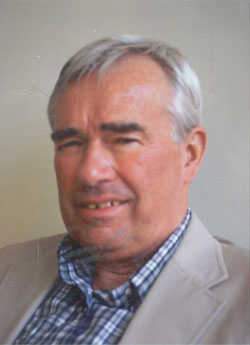G. Wilse Robinson Endowed Lectures

Dr. G. Wilse Robinson, Robert A. Welch Professor of Chemistry from 1975-2000.
This annual lecture series was endowed by former students, colleagues and friends of Dr. G. Wilse Robinson, Welch Professor of Chemistry at Texas Tech from 1975 until his death in September 2000.
Wilse Robinson was born in Kansas City, Missouri on July 27, 1924. He attended schools in Kansas City and Clearwater, Florida. Wilse served in the U.S. Navy during WW II in the Pacific theater, requiring at one point, memorization of the color-blindness test because he was quite red-green color blind! Wilse then enrolled at the Georgia Institute of Technology, where he earned both B.S. (1947) and M.S. (1949) degrees in Chemistry. His master's thesis, under the direction of Professor W. H. Eberhardt, concerned intensity perturbations in weak electronic transitions in molecular systems. He obtained his Ph.D. in Physical Chemistry at the University of Iowa (without a research advisor!) in 1952 for work on microwave spectroscopy and the theory of quadruple interactions.
In 1976 Wilse came to Texas Tech University, where Wilse was appointed Robert A. Welch Professor of Chemistry and Professor of Physics, positions he held until his death. At Texas Tech, Wilse established the Picosecond Spectroscopy and Quantum Radiation Laboratory to continue his investigations into condensed phases and, especially, aqueous dynamics. As a result of experimental studies in the 1980s of the solvent-dependent photophysics of naphthols and anilironaphthalene sulfonates, Wilse began to focus on the structure and dynamics of the hydrated electron and proton, and eventually on the structure of liquid water itself.
For nearly two decades, Wilse endeavored to understand liquid water with his focus being primarily on the fundamental problem of solvation, and the underlying issue of liquid water structure. His work in this area culminated in the publication of a book "Water in Biology, Chemistry and Physics: Experiment Overviews and Computational Methodologies" (World Scientific: River Edge, New Jersey, 1996) coauthored S.-B. Zhu, S. Singh, and M. W. Evans. His work on water was nearly entirely theoretical in character, including aspects of theory, modeling, and simulation, and included several publications on the general theory of condensed-phase reaction dynamics. His contributions in the area of solvation and liquid structure were distinctive in his consideration of a wide range of thermodynamic conditions and physical environments. These environments included bulk water, the solvation spheres of ions and solvated electrons, and interfacial water in films and at biomolecular surfaces.
Wilse concentrated most on developing and implementing a model of water that would faithfully describe the solvent density as a function of temperature and pressure, a feature that he felt was critical to any model that could accurately describe solvation in diverse contexts. The water model that emerged was based on a two-state mixture description of the components of the liquid, and emphasized the interaction of nonnearest neighbors in addition to the traditional focus on near-neighbor tetrahedral coordination. In the context of the model, the density maximum arises from outer-neighbor structural transformations. In 1996, Wilse developed a simple one-dimensional analytical model that is able to reproduce the density and other properties of water over a wide range of temperatures and pressures. Typically, the new ideas and approaches were applied to biological systems and, in 1999, he described a model for cold and heat denaturation of proteins in solution based on the temperature-dependent proportions of ice-Ih-type and ice-II-type bonding in the liquid.
Many of Wilse' views on liquids and solvation were controversial. But his unconventional thinking and strong defense of his own ideas reflected the imagination and determination that contributed heavily to his considerable impact on our current understanding of molecular systems. As before, his approach was outside the mainstream but introduced revolutionary ideas emanating from the desire to understand the physics governing the formation and stability of the various phases of ice as a prerequisite for understanding the liquid. Time will have to settle the question of the lasting contribution Wilse made to the understanding of liquid water, but to all who worked with him, Harry Gray's prediction that, "When the dust settles, and someday it surely will, Wilse Robinson will be recognized as the scientist whose work led to a fundamental understanding of the properties of this amazing substance" strikes a strongly resonant chord.
Robinson Lecturers
2024
Professor Daniel M. Neumark, University of California at Berkeley
TBA
2022
Professor Anna Krylov, University of Southern California
"Molecules and light: A story of life, death, and our quest for knowledge"
2015
Professor Sharon Hammes-Schiffer, University of Illinois
"Enzymes: The Engines of Biology"
2010
Professor Mostafa A. El-Sayed, Georgia Institute of Technology
"What is the Hype about Nanotechnology"
2007
Professor Peter G. Wolynes, University of California, San Diego
"Landscapes of the Sciences"
2006
Professor Richard N. Zare, Stanford University
"How to Succeed in Research"
2005
Professor William H. Miller, University of California, Berkeley
"The Remarkable Confluence of Theoretical Chemistry"
2004
Professor Dudley R. Herschbach, Harvard University
"The Impossible Takes a Little Longer"
2003
Professor Rudolph A. Marcus, California Institute of Technology
"Synergisms in Science: Theory and Experiment, Research and Teaching"
Department of Chemistry & Biochemistry
-
Address
1204 Boston Avenue, Lubbock, TX 79409-1061 -
Phone
806.742.3067
